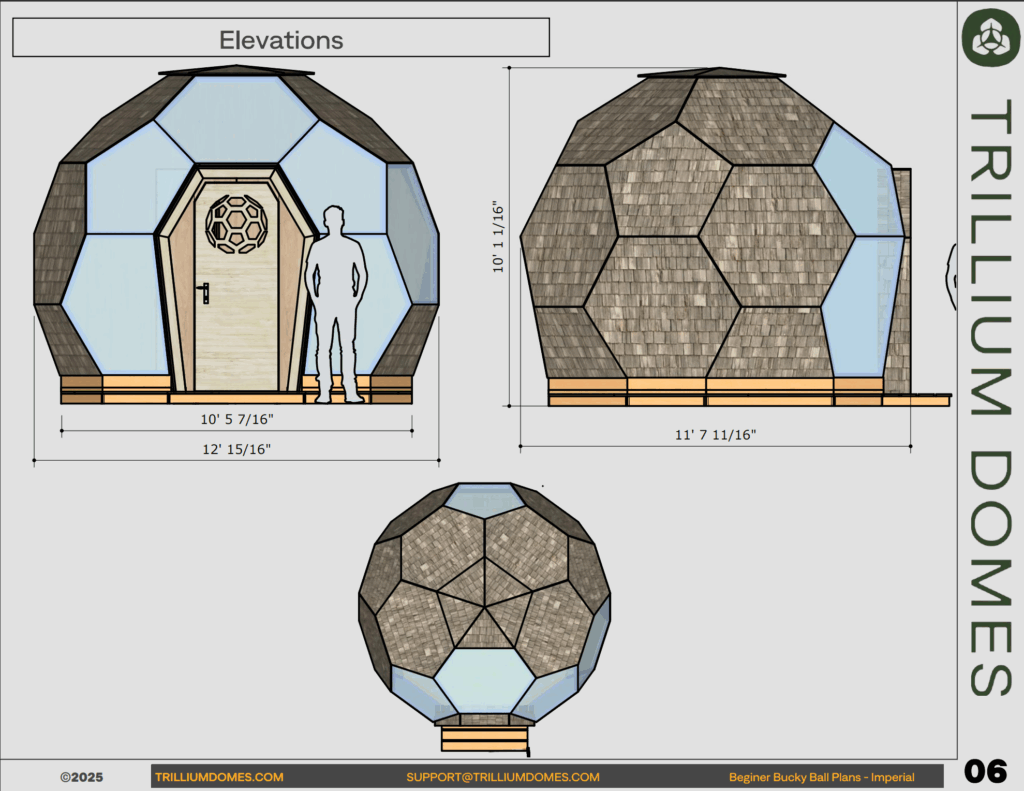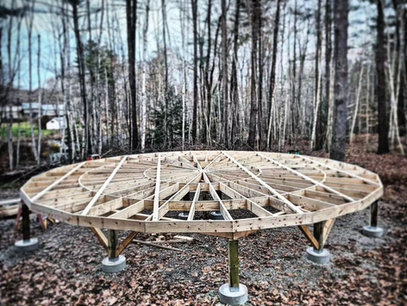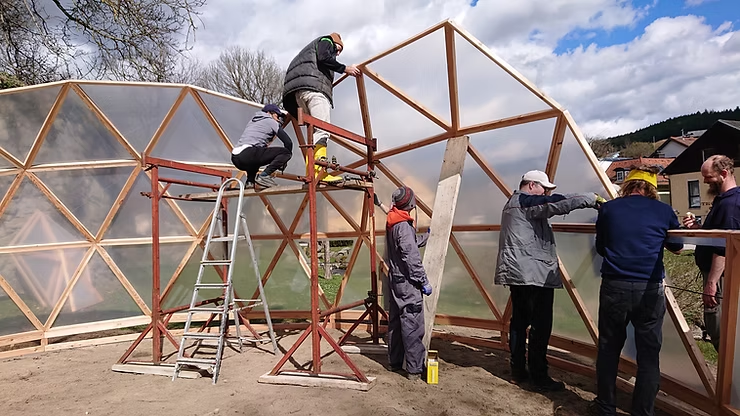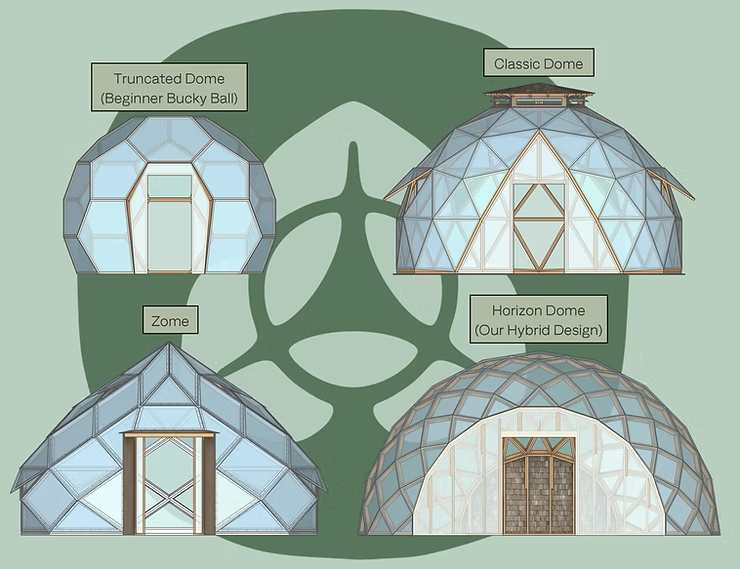How We Built a Geodesic Sauna Dome (Using the Beginner Bucky BallDome Plans)

Hey dome lovers — it’s been a while, but I’m finally back with a full build breakdown that I think you’re going to love. We built a fully functional sauna dome up in Alaska, using our updated Beginner Bucky Ball plans, and honestly? It turned out as good as I could have ever hoped. This was a project Camille and I took on with the help of my family, and it might be the most successful example of a dome sauna I have seen yet (if I don’t say so myself) We made a full build video that walks though all the steps AND massively updated the Beginner Bucky Ball Dome Build Plans and 3D Model… But I also wanted to give you a quick run down here so let’s get into the details. Why a Dome Sauna? This isn’t my first dome sauna — you might remember the little Acorn Zome. Big fire, small space = hot dome. But it had limitations. Most notably, the walls curve in starting pretty low, which means you can’t build benches that go higher than the sauna heater. And that’s a problem when you want your feet to be as warm as your head while the sauna is heating up. Also, there was no proper entryway or changing area. It absolutely works — but there’s always room for improvement. So I designed this new version to fix that. Let’s Build a Beginner Bucky Ball Dome Sauna! You can find all the measurements and illustrated steps laid out in full in our Beginner Bucky Ball Geodesic Dome Build Plans Cutting the Struts — Super Simple This dome has one bevel angle and one overall panel length. Therefore it only needs two unique struts — one for pentagons, one for hexagons. We cut ours from 2x4s ripped in half. That gives you two struts per board. If you want thicker insulation, you can go bigger — just know you’re limited by the depth of your table saw with the beveled method. You can either use the deep frame method (see my youtube video on that) or build a scaled down dome inside this one to create as much of an insulation layer as you want. Once your stock is ripped, you cut your miters. The initial miter goes on one end of all your struts. Then we create a simple template to get your strut length, locating the final miter. I like to set up a stop block so I can make consistent repeat cuts once I’ve got the angles dialed in. Building the Panels Each dome face is either a hexagon or a pentagon. Once you’ve got all your struts cut, you can start assembling panels. I use GRK R4 screws — they’re structurally rated and don’t split the wood. For partial panels, like the ones around the doorway, I build full ones and cut them down. You can add corner blocks for extra strength — these are optional, but I like them. They’re just angled 2×4 chunks that stiffen each panel. In the video and plans I show how to set up an auxiliary fence on the miter saw to make the acute angles a breeze. Sheathing and Underlayment For the sauna, we used 3/4″ CDX plywood for the panel sheathing. It’s not structural in this case — the frame itself carries the load — so the plywood just gives us a nailable surface for our underlayment and roofing. We applied roofing underlayment (Grace Ice & Water Shield) before assembling the dome. We left a 6″ overhang on all sides, and during the build, we peeled the backing and stuck them together shingle-style — top over bottom — which created a completely waterproof seal. Work your way from bottom to top, underlapping and overlapping. If you’re using polycarbonate, I recommend trimming it slightly smaller than the panel and leaving a small gap between sheets. I show how to do this simply with a jig in my Ultimate Dome Builders Video. You can seal the gaps with double-sided glazing tape and clear silicone. The Base and Deck The dome sits on L-shaped base sections made from a 2×4 and a 2×6. These create a raised perimeter to attach the dome to your foundation. The bevel and miters make them fit snug around the dome’s footprint. As for the deck, you’ve got three main options: Assembly Day Once the base was locked down, we started assembling the dome panels. I always start at the back and work toward the front (doorway side), working bottom to top. A helper and a small ladder are all you really need for a dome this size. We used screws to attach panels and only tacked them together until the whole structure was up. Then we went back and added extra screws every 6 inches. Once the shell was up, we sealed the polycarbonate seams, trimmed the underlayment, and moved on to finishing the inside. The Interior Wall and Benches In the video I show a really easy way to panelize the interior cladding of the dome panels. This streamlines the process 1000% and make the installation a breeze. Repeatable shapes for the win! We added a freestanding interior wall to divide the hot room from the changing room. It doesn’t carry any load — it just gives us a place to frame the benches and helps keep the heat where we want it. We marked it using a 360° laser level to trace the shape of the dome, then framed it in place using standard 2×4 studs. From there, we built the benches — starting with ledger boards, then adding verticals and horizontal supports. The layout is pretty creative because, ya know, domes! but that’s also what makes it special. You could totally freestyle this, or follow the version in our plans and 3D model exactly. I’ve included every cut you need to make for the interior wall and illustrated the benches in detail. Finishing Touches We cover
Estimating Costs for Your Trillium Dome or Zome Build – The Complete Guide

How much will it cost to build a dome or zome? While the unique design of a geodesic dome can be more efficient than conventional structures, the cost will depend on several key factors. This guide will break down the costs to give you a better understanding of what to expect when budgeting your dome or zome build. Whether you’re constructing a greenhouse, cabin, or sauna, we’ve got you covered with cost estimates and tips for making your project more affordable. From Trillium Domes 30′ / 9m Dome Plans – Built by Mac, Domes of Maine What Are the Key Factors That Affect Dome and Zome Building Costs? What is the Cost Per Square Foot of a Trillium Dome or Zome Build? Six Example Dome and Zome Builds to Inspire You – And Their Associated Costs! What Are the Key Factors That Affect Dome and Zome Building Costs? Every Trillium Domes plan as of Oct 2024 1. Size of the Dome The size of your dome is one of the biggest factors in determining the cost. Larger domes require more materials and, if you’re hiring help, more labor. However, larger domes also tend to be more efficient on a per-square-foot basis when it comes to materials. 2. Site Location Where you build your dome will influence the cost in a variety of ways. Some areas have higher labor costs, stricter permitting processes, or more expensive materials. If you live in a rural area, you might also face transportation costs for delivering materials. 3. Materials Sourcing Your material choices can make a huge difference in your overall cost. Using recycled or locally sourced materials can help cut down costs, but new, premium materials will raise your price point. Trillium Domes offers material plans in product descriptions to help you plan. 4. Foundation Type Foundations vary in cost, from a basic packed gravel foundation to more complex wood decks or concrete pads. Your foundation choice will depend on the dome’s purpose, the terrain, and your budget. 5. Intended Use Whether you’re building a greenhouse, a small cabin, or a sauna, the intended use will dictate the materials and design choices, impacting the overall cost. Greenhouses typically have lower costs for covers, while insulated cabins and saunas require more expensive materials. 6. Types of Finish Finishing touches like flooring, doors, and insulation can dramatically alter the final price tag of your dome. A simple greenhouse might not need any flooring, whereas a fully finished cabin will require more expensive insulation and utilities. What Is the Cost per Square Foot for a Trillium Dome or Zome Build? In conventional construction, costs are often measured in price per square foot. If you are hiring for a full dome or zome home build, the overall costs are going to be comparable to your price per sq ft to build a conventional home in your area. If you’re looking to DIY or get a Trillium Kit, you can save a lot on the overall cost of the project. Here’s how different dome and zome project types compare: Greenhouse Domes Cabins, Saunas and Community Spaces Labor Costs Six Example Dome and Zome Builds to Inspire You – And Their Associated Costs! 1. 200 Sq. Ft. Greenhouse Dome From Trillium Domes 15′ / 4.5m Dome Plans – Built by Brad in Oregon 2. 300 Sq. Ft. Cabin Zome From Trillium Domes 20′ / 6m Zome Plans – Built by Zen n Den in the UK 3. 400 Sq. Ft. Cabin Dome Shell From Trillium Domes 23′ / 7m Dome Plans – Built by The W School in Puerto Rico 4. 500 Sq. Ft. Fully Finished Tiny Home Zome From Trillium Domes 25′ / 7.5m Zome Plans – Built by Laurel Zome in Georgia 5. 600 Sq. Ft. High-End Greenhouse From Trillium Domes 30′ / 9m Dome plans – Built by Karl in Estonia 6. 100 Sq. Ft. Dome Sauna From Trillium Domes Beginner Bucky Ball Dome Plans – Built by Trillium Domes in Alaska Feeling Ready to Build Your Own DIY Dome or Zome? By breaking down the costs associated with a dome or zome build, you now have a clearer idea of what to expect. Whether you’re planning a simple greenhouse or a fully finished cabin, your dome project can be customized to fit your budget. The example builds above show that no matter your purpose, there’s a dome design that can meet your needs at various price points. Ready to start your dome journey? Check out our build plans for detailed materials lists and step-by-step instructions. Have more questions? Leave a comment below or reach out to us for personalized guidance. With the right plan in place, your dome or zome project will be both a creative and cost-effective success!e or zome project will be both a creative and cost-effective success!
Choosing the Right Foundation for Your Dome or Zome Build – Full Guide

Where you build your dome will influence the cost in a variety of ways. Some areas have higher labor costs, stricter permitting processes, or more expensive materials.
Choosing the Best Material for Your Greenhouse Dome or Zome – The Complete Guide

Where you build your dome will influence the cost in a variety of ways. Some areas have higher labor costs, stricter permitting processes, or more expensive materials.
Choosing the Best Roofing Material for Your Dome or Zome – The Ultimate Guide

You may want to build a dome and wonder – How do I roof and geodesic dome or zome? Choosing the right roofing material for your dome or zome is essential for ensuring its longevity and performance, especially when considering factors like climate and budget. Whether you’re planning an insulated dome for year-round use or a seasonal structure, there are many options available. Each material has its strengths and weaknesses depending on your environment, but making the right choice will provide you with a dome that’s protected from the elements and built to last. The materials presented below are specifically for geodesic dome and zome cabins, short term rentals, glamping, sauna and community spaces. For info on dome and zome greenhouse materials, check out this post. At Trillium Domes, we’ve spent years perfecting our dome designs, and our Ultimate Geodesic Dome and Zome Build Plans account for various roofing materials to suit different climates. This guide will walk you through the best options available, from traditional shingles to high-performance aluminum shakes, so you can make an informed decision that fits your needs. By the end of this post, you’ll be well on your way to choosing the perfect roofing material for your dome or zome! High Quality Roofing Underlayment and Roofing Materials Goes a Long Way to Protecting Your Dome or Zome! From our 20′ / 6m dome plans – Built by SeaTsu Sauna in Washington #1: Why Choosing the Right Roofing Material Is So Important #2: The Best Roofing Materials for Dome and Zome Structures #3: The Next Step Toward Roofing An Affordable DIY Dome or Zome Why Choosing the Right Roofing Material Is So Important The roofing material you choose will dictate your dome’s ability to withstand rain, wind, and temperature fluctuations. It’s not just about aesthetics—your choice will affect how energy-efficient your dome is, how often it requires maintenance, and how well it handles long-term exposure to the elements. Historically, domes have used everything from shingles to sheet metal, and each material provides unique benefits depending on the environment. If you’re in a rainy area, you’ll want something water-resistant like aluminum or composite roofing. In arid climates, more affordable options like elastomeric coatings might be sufficient. With our Geodesic Dome and Zome Build Plans, we guide you through how to properly install each roofing material, ensuring the most efficient and durable outcome for your project. The Best Roofing Materials for Dome and Zome Structures Let’s dive into the most popular and effective roofing materials you can use for your dome or zome. As always, consider your climate, intended use, and budget when making a decision. I’ll also include some pricing information to help you estimate the cost of your roofing materials. 1. Elastomeric Coating: Budget-Friendly for Arid Climates From our 10’6 / 3.2m Zome Plans – Built by Oran in Wyoming Elastomeric coating is a cost-effective solution for domes in arid climates where rainfall is minimal. It’s an elastic polymer that can be applied over a plywood subroof and painted for added protection. However, this material is not ideal for rainy regions, as prolonged exposure to moisture will degrade the coating over time. For our customers building in dry climates, the build plans offer detailed steps for applying elastomeric coatings effectively, though we recommend more durable options for wetter environments. 2. Asphalt Shingles: Versatile and Cost-Effective From our 16′ / 5m Zome Plans – Built by Kate and Robb in Canada Asphalt shingles are a common roofing material, and they’re a solid option for most dome projects. They’re relatively inexpensive, widely available, and perform well in a variety of climates. However, ensuring proper flashing and using a solid roofing underlayment are critical to preventing leaks. Our Geodesic Dome and Zome Build Plans cover how to install shingles on domes, emphasizing the importance of proper underlayment and flashing to ensure a long-lasting roof. 3. Aluminum Shakes: Durable and Ideal for Domes and Zomes Aluminum Shakes and Polycarbonate – From our 25′ / 7.5m Zome Plans – Laurel Zome BnB in Georgia Aluminum shakes is my personal favorite roofing material for geodesic domes and zomes. Their flexibility allows them to bend around dome facets, making them ideal for the unique geometry of a dome or zome roof. Aluminum is highly resistant to weather, including rain, wind, and snow, and when paired with a high-quality underlayment, it provides exceptional protection. In our build plans, we provide detailed instructions on how to properly install aluminum shakes on domes to ensure a tight, weatherproof seal that lasts for decades. 4. Thermoplastic Polyolefin (TPO): High Performance at a Mid-Range Price TPO and Polycarbonate – From our 25′ / 7.5m Zome Plans – Earth Alchemy in Georgia TPO is a single-ply roofing membrane that offers excellent UV and heat resistance. It’s a great option for domes in sunny areas and can be heat-welded to provide a strong, durable seam. This material is relatively cost-effective and performs well in a variety of climates, making it a popular choice for dome builders. If you’re looking for a balance between performance and cost, TPO is an excellent choice, and our geodome and zome woodworking plans detail how to properly apply this material to dome surfaces. 5. Sheet Metal Roofing: A Strong and Versatile Choice From our 30′ / 9m Zome Plans – Built by Austin Permaculture Guild in Texas Sheet metal roofing is another fantastic option for domes and zomes, especially in areas with extreme weather conditions. Whether you’re facing heavy rain, snow, or high winds, metal roofing provides excellent durability and weather resistance. It’s available in various forms, from corrugated metal sheets to standing seam panels, each offering different aesthetics and performance benefits. Sheet metal is particularly well-suited for geodesic domes due to its ability to conform to the dome’s shape when properly cut and installed. It’s also highly energy-efficient, reflecting sunlight and reducing cooling costs during hot summer months. Custom panels can be cut to fit the panels and even be hemmed together to prevent water ingress. Standing
What is the difference between a Dome and Zome? (and other geodesic structure types)

Where you build your dome will influence the cost in a variety of ways. Some areas have higher labor costs, stricter permitting processes, or more expensive materials.